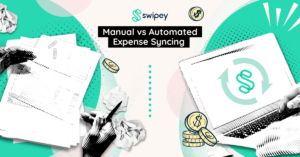As a business owner, you always want to ensure that your finances are in order and that your employees respect and follow the financial policies that you’ve set. However, even with the best systems in place, there’s always the possibility of fraud.
Did you know that business expense frauds are some of the most common types of fraud that can occur in a company? In fact, according to the Association of Certified Fraud Examiners (ACFE), 11% of all asset misappropriation in 2021 was due to expense claim fraud. If left unmanaged, expense fraud will contribute to company losses. The same study above showed that small businesses (fewer than 100 employees) incurred the highest median loss of USD 150,000.
In this blog post, we’ll explore the five types of business expense frauds that commonly happen and the practical solutions that you can follow to better manage your finances.
What Is Expense Fraud?
The ACFE defines expense fraud as “a fraudulent disbursement scheme in which an employee makes a claim for reimbursement of fictitious or inflated business expenses (e.g., employee files fraudulent expense report claiming personal travel or nonexistent meals).”
Remember that there’s a chance for business expense frauds to happen accidentally due to human errors, like accidentally submitting the same receipt twice. So, it’s important to understand why and how company expense frauds happen in the first place so that you can properly address them.
Types of Business Expense Frauds and How to Solve Them
The five types of expense claim fraud are:
- Ghost employees
- Overstated expenses
- Mischaracterized expenses
- Multiple reimbursements
- Fictitious expenses
Now, let’s explore each fraud in detail and learn how to curb them.
Ghost employees
Ghost employees are fictitious employees that are added to the payroll system in order to siphon off money from the business. These fictitious employees are often created by a fraudster using fake names and identity numbers, and the payments made to them are then redirected to the fraudster’s bank account. The fraudster may claim overtime for hours not worked or even siphon salary monthly. Technically, this type of fraud falls under the payroll scheme according to the ACFE.
Solution
One way to prevent ghost employees is to conduct thorough background checks on all employees before hiring them. This can help identify any red flags or inconsistencies in their employment history or personal information. It’s also important to regularly review the payroll system and cross-check it with employee files to ensure that all employees are legitimate. You must also conduct regular housekeeping when it comes to overtime payment policy.
Overstated expenses
Overcharging expenses is when an employee inflates the amount of an expense in order to receive more money from the company. This can include expenses like inflated hotel bills, restaurant expenses, and travel costs.
Solution
To prevent overcharging expenses, it’s important to have clear policies and guidelines in place for what expenses are allowable and how they should be documented. For example, you can set a limit for daily expenses for traveling employees. This ensures that they’re only spending within the stipulated budget. Additionally, it’s important to have a system for reviewing and approving expenses, such as requiring receipts for all expenses over a certain amount or having an expense review committee. This is where having an expense management system in place can do wonders for automatic and accurate expense tracking.
Mischaracterized expenses
Another common type of business expense fraud is when an employee uses company funds to pay for personal expenses but then disguises them as business expenses. This can include things like personal shopping, dining out, or even personal vacations.
Solution
To prevent this type of fraud, it is important to have a clear separation between personal and business expenses. This can be done by having clear guidelines to classify business expenses in the first place. The classifications should also state the different types of business expenses (e.g., travel expenses, meal expenses, membership expenses). After that, make it a point to require all employees to submit detailed receipts and documentation for all expenses, as well as by having a system in place to regularly review and approve expenses.
Duplicated reimbursements
Duplicated expense submissions occur when an employee submits the same expense more than once, in order to receive double payment for the same expense. In some cases, employees may do this because they feel like the company “owes” them money due to improper reimbursements. On the other hand, this can happen accidentally too.
Solution
To prevent duplicate expense submissions, consider conducting selective audits to detect any inaccuracies. But since this is a time-consuming and resource-intensive activity, only do it when you suspect a fraud had happened. Another best practice is to set a cutoff period for staff to submit their expense claims. For example, you can ask them to submit their expense claim within the same calendar month the expense took place. On top of that, make sure that you’re properly reimbursing your employees as well as having fair and up-to-date allowance rates. It not only reduces fraud but also boosts employee morale and productivity.
Fictitious expenses
Fictitious expenses are expenses that are completely made up by an employee in order to receive payment from the company. This can include things like fake travel expenses, fake vendor bills, and even fake invoices. It’s also common in companies that don’t require receipts for purchases under a certain amount.
Solution
You can prevent the occurrence of fictitious expenses by making sure that all expense claims are supported by original receipts. Also, consider making your expense claim submission process digital so that employees won’t misplace their original receipts and can still submit original receipts and invoices online. It’s important to have a working process for vetting vendors and ensuring that all invoices and receipts received are legitimate and authorized.
Make Your Business Expense Claim Process Fraud-Free
Business expense fraud is a serious issue that can cost companies thousands of ringgit every year. By understanding the different types of business expense fraud and implementing the solutions outlined above, you can protect your company from financial loss.
Swipey’s all-in-one expense management dashboard and prepaid cards give you complete visibility into expenses incurred by employees. It’s a fully digital platform available as a web dashboard and mobile app which make business payments simple and give you full control over the company budget.
If you’re interested in exploring Swipey to better manage your expense claim submission process that’s free from fraud, sign up now! Or watch the demo!




